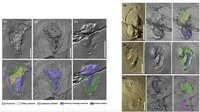Footprints in the Sands of Time
 Reevaluating Human Origins with the Crete Discovery
Reevaluating Human Origins with the Crete Discovery
A single footprint can hold a universe of stories. In the realm of human evolution, footprints left behind in ancient sediments offer a rare window into the past, whispering tales of our long-lost ancestors. A recent discovery on the Greek island of Crete has sparked a debate that could rewrite the opening chapters of humankind's saga. The YouTube video, titled "Does this Footprint Prove The First Humans Were European?" delves into this captivating find and its potential to challenge our understanding of human origins.
For decades, the prevailing narrative placed the cradle of humanity firmly in Africa. Fossil evidence, such as the famous Australopithecus remains, pointed towards this continent as the birthplace of our earliest ancestors. The Laetoli footprints in Tanzania, estimated to be 3.7 million years old, further solidified this view by showcasing clear examples of bipedalism in early hominins. However, the Crete footprint discovery throws a pebble into this seemingly settled pond. Dated at a staggering 5.7 million years old, these footprints suggest a human-like presence in Europe significantly earlier than previously thought.
The video likely dissects the scientific analysis of these footprints. Techniques like radiometric dating provide an estimate of the sediment's age, placing the footprints firmly in the Miocene epoch. Further analysis of the impressions themselves can reveal details about the foot's size, shape, and potential biomechanics. While definitive identification of the footprint maker remains elusive, the size and general morphology hint at a bipedal creature with feet somewhat similar to our own. Homo antecessor, an early human relative known to have inhabited Europe around that time, could be a possible candidate.
However, the video would likely emphasize the limitations of relying solely on footprints for conclusive answers. Unlike fossilized remains, footprints lack the definitive anatomical markers needed for precise species identification. The possibility of these prints being made by an unknown hominin species or even an entirely different bipedal creature cannot be entirely ruled out.
Despite the limitations, the sheer age of the Crete footprints holds immense significance. Regardless of the species that made them, the discovery pushes back the timeline of human-like locomotion in Europe by a staggering two million years. This challenges the traditional theory of a strictly linear migration from Africa and suggests a potentially more complex scenario.
The video might delve into the implications of this new timeline. If early hominins were indeed present in Europe millions of years ago, it compels us to consider the possibility of multiple evolutionary centers or perhaps a more interconnected picture of early human dispersal. Perhaps our ancestors weren't confined to a single continent but ventured out and explored diverse ecological niches early on.
Further research into hominin dispersal routes and the ecological factors that influenced their movements could be another focus of the video. Understanding the environmental conditions of Miocene Europe might shed light on what kind of creatures roamed the landscape and what factors might have facilitated the development of bipedalism. Additionally, the video might explore the possibility of similar discoveries elsewhere in the world. Footprints found in New Mexico, dated between 21,000 and 23,000 years old, offer another piece of the puzzle, hinting at complex migration patterns and potentially much older human activity in the Americas.
The Crete footprint discovery, along with other emerging evidence, compels us to move away from a simplistic "Out of Africa" narrative. The video likely emphasizes the need for a more nuanced understanding of human evolution, one that acknowledges the possibility of geographically widespread origins with Africa still playing a central role.
However, the video wouldn't shy away from acknowledging the challenges involved in rewriting established theories. Reconciling the new evidence with existing fossil records and genetic data will be crucial. Further research and discoveries are needed to build a more robust picture of our early ancestors' lives and movements. This could involve the meticulous excavation of promising sites in Europe and beyond, along with employing cutting-edge analytical techniques to extract maximum information from existing and future findings.
In conclusion, the YouTube video "Does this Footprint Prove The First Humans Were European?" serves as a springboard for a critical reevaluation of human origins. It highlights the power of a single footprint to challenge long-held beliefs and ignite a scientific quest for deeper understanding. While the Crete find doesn't definitively rewrite history, it compels us to explore a more intricate tapestry of human evolution, one woven with threads from multiple continents and reflecting a journey that began much earlier than previously imagined. This discovery is a testament to the enduring power of scientific inquiry and the constant evolution of our understanding of ourselves.
Mind Detour offers humorous, educational and interesting articles and videos to detour your mind from the everyday grind.
Be sure to follow us on Twitter and like our page on Facebook.
Thank You for visiting my site, I really appreciate it! Please do me a huge favor and share my articles with your friends on social media.



